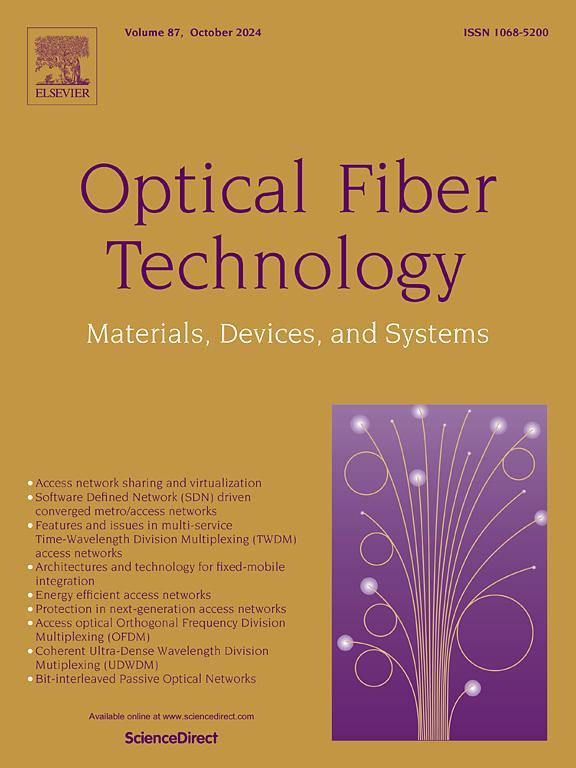o波段两级和三级三通pdfa性能评价
IF 2.7
3区 计算机科学
Q2 ENGINEERING, ELECTRICAL & ELECTRONIC
引用次数: 0
摘要
可调谐激光源(TLS)、掺镨光纤(PDF)和泵浦激光器是掺镨光纤放大器(PDFA)设计的主要组成部分。从成本和性能(如增益、功率转换效应[PCE])的角度来看,确定这些元件的重要参数值对于设计是非常必要的。对于TLS,信号波长和功率;为PDF, PDF长度、离子密度、上转换、数值孔径、芯半径、掺杂半径、工作环境温度;泵浦激光、泵浦功率和泵浦波长是关键的设计参数。另一个提高放大器性能的因素是放大器的配置。虽然文献中有单通道和双通道的PDFA研究,但本文首次对两段三通道PDFA (2P3S-PDFA)和三段三通道PDFA (2P3S-PDFA)进行了仿真、参数优化和分析。比较了2P3S-PDFA和2P3S-PDFA的增益和噪声系数(NF)。2S3P-PDFA获得的最佳增益为49.4 dB,此时的NF约为6.5 dB。对于3S3P-PDFA,最佳增益为47.7 dB,此时的NF约为5.1 dB。当我们从总体上看这两种放大器类型时,就最佳增益而言,2S3P-PDFA的性能优于3S3P-PDFA约1.7 dB。然而,就NF而言,2S3P-PDFA的NF比3S3P-PDFA高约1.6 dB。优化的结果是,在增益方面,2S3P-PDFA系统比3S3P-PDFA系统更有效。本文章由计算机程序翻译,如有差异,请以英文原文为准。
Performance evaluation of two-stage and three-stage triple pass PDFAs in O-band
Tunable laser source (TLS), doped fiber (PDF), and pump laser are the main design components for the praseodymium doped fiber amplifier (PDFA) design. Determination of the important parameter values of these components for the design is quite essential in terms of cost and performance (e.g., gain, power conversion effect [PCE]). For TLS, signal wavelength and power; for PDF, PDF length, ion density, upconversion, numerical aperture, core radius, doping radius, and operating environment temperature; pump laser, pump power, and pump wavelength are the critical design parameters. Another factor that will improve the performance of the amplifier is the amplifier configuration. Although there are single-pass and double-pass PDFA studies in the literature, in this article, for the first time, the simulation, parameter optimization, and analysis of two-stage triple-pass PDFA (2P3S-PDFA) and three-stage triple-pass PDFA (2P3S-PDFA) are performed. The performances of 2P3S-PDFA and 2P3S-PDFA are compared in terms of gain and noise figure (NF). The optimum gain obtained for 2S3P-PDFA is 49,4 dB, and the NF at this point is around 6,5 dB. For 3S3P-PDFA, the optimum gain is 47,7 dB and the NF at this point is around 5,1 dB. When we look at the two amplifier types in general, 2S3P-PDFA performs better than 3S3P-PDFA in terms of optimum gain by around 1,7 dB. However, in terms of NF, 2S3P-PDFA has more NF than 3S3P-PDFA by around 1,6 dB. As a result of the optimization, it is seen that the 2S3P-PDFA system is more efficient than the 3S3P-PDFA system in terms of gain.
求助全文
通过发布文献求助,成功后即可免费获取论文全文。
去求助
来源期刊

Optical Fiber Technology
工程技术-电信学
CiteScore
4.80
自引率
11.10%
发文量
327
审稿时长
63 days
期刊介绍:
Innovations in optical fiber technology are revolutionizing world communications. Newly developed fiber amplifiers allow for direct transmission of high-speed signals over transcontinental distances without the need for electronic regeneration. Optical fibers find new applications in data processing. The impact of fiber materials, devices, and systems on communications in the coming decades will create an abundance of primary literature and the need for up-to-date reviews.
Optical Fiber Technology: Materials, Devices, and Systems is a new cutting-edge journal designed to fill a need in this rapidly evolving field for speedy publication of regular length papers. Both theoretical and experimental papers on fiber materials, devices, and system performance evaluation and measurements are eligible, with emphasis on practical applications.
 求助内容:
求助内容: 应助结果提醒方式:
应助结果提醒方式:


